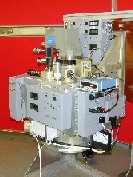
 |
Rotational transitions of simple molecules occur in the submillimetre-wave part of the spectrum, making it important for studies of star-forming regions, the inter-stellar medium, etc. It is usual to observe trace elements of these molecules, embedded in much denser clouds of molecular hydrogen. Detailed analysis of the spectral line shapes can be used to determine, for example, temperatures, densities and motion. Both physical and chemical models of conditions within the molecular cloud can be devised. Many molecular species form on the surfaces of carbon grains, making the study of neutral carbon very important also. |
|
The most important type of instrumentation is the heterodyne receiver, which uses a detector with a non-linear response (mixer) to downconvert information from the signal frequency to a much lower frequency (IF) where it can be amplified and recorded as a spectrum. Crucial components are the mixer detector itself and a source (local oscillator) of continuous-wave power in the same frequency range as the signal you want to detect. The best noise performance is obtained using superconducting mixers. |
 |
 |
In
a collaborative project between the University
of Kent, the Rutherford Appleton
Laboratory and the University of Bath, an
800-900 GHz SIS Receiver
is currently being built for
the TIRGO
Infrared Telescope on the Gornergrat, Switzerland.
Superconducting hot-electron bolometer mixers are being developed as alternatives to SIS (superconductor-insulator-superconductor) detectors.
|
SRD 21 Jan 05